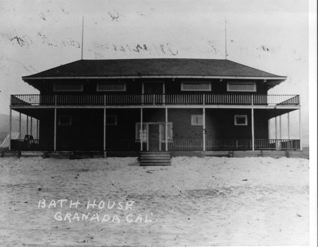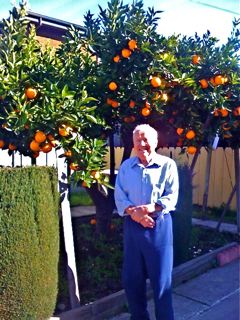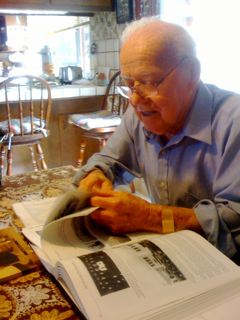Who lived in the El Granada Bathhouse during Prohibition?
Story & photos by June Morrall. Bathhouse photo courtesy Redwood City Main Library.
I didn’t know anyone had actually lived in the El Granada Bathhouse–and used it as a home. When I arrived on the Coastside in the 1970s, the bathhouse was gone but I saw remnants of a road, big chunks of which had been and were still being torn apart by the highest of the high tides. If there had been a road there, then, clearly there had also been a lot of terra firma on the west side, the ocean side of the concrete, land once planted in rich fields of artichokes and Brussels sprouts. All gone now as Mother Nature shows us who rules.
The two-story “Bathhouse” was originally part of the Ocean Shore Railroad era, built in the early 1900s as a place for beach-goers to change into their bulky, old-fashioned swim-wear.
By now you know that the railroad’s “mandate” was to open up the isolated Coastside and provide the farming community with a new economy based on tourism. But Mother Nature, tough competition from the Southern Pacific on the other side of the hill, and a powerful love affair with the automobile took the Ocean Shore down.
Then the funniest thing happened: Alcohol, one of the popular drinks being whiskey was banned by the Prohibition Act, and, the dry law, like any law that says you can’t do something, encouraged the innovation of human nature to quench thirst. The natural response was to figure out a way to beat Prohibition. What the law breakers needed was a place to land the illegal booze, an isolated, secluded beach, recently abandoned by the railroad—and fearless men and boys to carry out the rest.
In the mid-1920s Gino Mearini and his family moved into the El Granada Bathhouse. Gino was just a kid, a teenager, smart as a whip, the son of Alesseio, who left his home in Tuscany seeking a better life in the US in 1914– at the beginning of WWI.
Alessio arrived without his wife and children; when he was doing better, he’d bring the family to live with him. The first job Alessio took was working in the dismal Pennsylvania coal mines before heading west to the Coastside where fellow Italians were farming artichokes and Brussels Sprouts.
(Photo: Gino Mearini stands in front of his bountiful orange tree.)
It was inevitable that Alessio would meet Dante Dianda, the big man in El Granada, the Coastside’s “Artichoke King.” Dianda, in partnership with John Patroni, who ran the Patroni House in Princeton-by-the-Sea owned two large ranches, encompassing Princeton, El Granada and Miramar. (Later, when Dante temporarily moved his family from El Granada to San Francisco, the farmer discovered that he enjoyed working at the busy San Francisco Produce Market much more than overseeing the two sprawling Coastside ranches.)
“Can you cook?” the Artichoke King asked Alessio Mearini.
“Yes!” was the younger man’s reply and Alessio was offered a job cooking for the men at the ranchhouse up the canyon in El Granada.
Alessio Mearini possessed a solid work ethic and business sense. Soon his cooking days were over and he was Dante’s partner, helping to manage the El Granada-Miramar ranch.
Earlier this week I was invited to Gino Mearini’s home in Cupertino. His lovely daughter, Janet Mearini Debenedetti was there, too–the owner of six cats, one of them most entertaining as she wrestled with Jo-Jo, Gino’s 10-year-old irresistible, recently shaved Pomeranian. Janet’s house stands across the street from her dad’s, and she said they bought the property on their street a long time ago, when the area was more rural. The climate reminded them of Italy, she explained.
We gathered at the kitchen table, a light-filled room (Burt sat across from me, with Gino at the head of the table, Janet at the opposite end. Janet grew up on the Coastsider, attending school with well known “Princetonians” Eugene Pardini and Ronnie Mangue.
I noted the small stack of books, all historical: Barbara Vanderwerf’s “Granada, A Synonym for Paradise;” Michael Orange’s “Half Moon Bay: Historic Coastside Reflections, ” and two of mine, “Half Moon Bay Memories: The Coastside’s Colorful Past,” and “Princeton-by-the-Sea.”
Gino wouldn’t like it if I revealed his age, but he has the spirit and curiosity of a young guy.
. (Photo: Gino Mearini looks at a page in Michael Orange’s book.)
Gino and his mom traveled from Italy to El Granada about 1921. At first they lived in a little house near where the El Granada Market stands today. A few years later the Mearinis moved into the vacant El Granada Bathhhouse.
The era belonged to Prohibition–and while the Bathhouse had become a home– when a light in the upstairs bedroom was flicked on past midnight, that was the “come on in, boys” signal–and the rumrunners boated in to El Granada Beach the bottles of whiskey unloaded from the Canadian mother ship anchored 12-mile out in the Pacific.
This was very, very serious business. Big money was involved. Thousands of cases of booze. The product had to be protected.
“There were bootleggers, armed with revolvers, looking for liquor hijackers at Miramar and El Granada,” Gino told me. But if it came down to a close chase with the Coast Guard, headquartered at Princeton, “We’d rather throw the load overboard than lose the boat. They had two Liberty motors, and they were fast engines.”
Gino, a teenager at the time, earned $25 for two hours of work, helping to drag the booze, that might have been tightly packed in gunny bags, across the sand dunes on homemade “sleds.” If John Patroni wasn’t around to pay Gino, “Otto and Anderson,” the Norwegians connected with the Canadian Mother ship, did.
What happened to the whiskey then? Gino said, “It was packed in straw, hidden in a nearby barn, and later picked up by some young guys driving a maroon colored Chrysler. There were velvet curtains covering the windows, maybe seven passengers could fit in there, boy, was it big.”
The drivers of the maroon Chrysler worked on contract, picking up at locations all over the county.
John Patroni was the “padrone,” the man who took care of the local Italians. He had nice cars, first a blue Packard, and then the fancy Cadillac. But who did John Patroni work for? I still can’t answer that question……
During our delightful conversation, Gino would correct things I had written. Clearly, while John Patroni had his own wharf at Princeton, where lots of whiskey was also landed, the El Granada Bathhouse may have played a much bigger role. In one of my books, I mentioned that booze was hidden beneath seawood mounted on a raft and pulled in. No, Gino said, “not possible.”
(Well, maybe it did happen but it sure sounds like nickel-and-dime stuff compared to the thousands and thousands of cases landed at El Granada.)
By 1933, the financial depression was hitting the Coastside hard, and because Prohibition was repealed, there was no more money to be made from illegal booze–but Gino had saved $600, all earned from working for the rumrunners.
The Mearini family moved out of the Bathhouse in February, 1932, and headed south of Half Moon Bay to isolated Lobitos where they rented John Meyn’s big white house. They later purchased land near where the trailer court is located on Airport Blvd., between Princeton and Moss Beach.
WWII on the Coastside is of particular interest to me, and Gino confirmed that all Italians without citizenship had to move from the beach side of the highway to the east side. (The Coastside Japanese had been interned.) In the town of Half Moon Bay, the center of Main Street was the dividing line. Gino had a lot of empathy for the “women and widows that had to move.” Unfortunately, most of the stores were on the west side of Main Street, causing much distress.
The Prohibition years were heady ones for the teenager, Gino Mearini, but one thing sticks out in his memory. At 6 a.m. in 1924, his mom called to him: “We’re going to get washed away.”
When Gino looked out the window he saw it coming towards him: a series of giant, hungry waves, an old-fashioned “Tidal Wave,”… a modern Tsunami. The family got out before the chicken house, packing shed and squealing pigs were swept away (the pigs survived.)
But when it was all over, the Bathhouse had been turned around a bit, and moved into the artichoke field. The beach around the house was gone. Years later as the sea chewed on more of the cliffs and sucked out the sand dunes, the waves finally claimed the Bathhouse as its own.
Occasionally, Gino Mearini visits the Coastside, and amusement crosses his face when he comes to the spot where the El Granada Bathhouse once stood. Actually, there is no such spot.
Over time the action of the waves has so altered the geography of what was here and what was there in the 1920s, that Gino can only smile and point, “The bathhouse, it’s out there, where the ocean is.”



